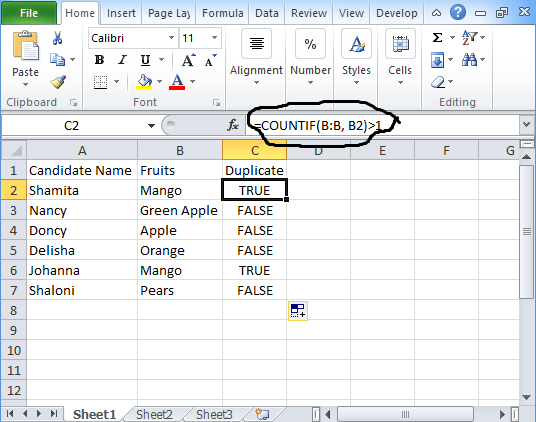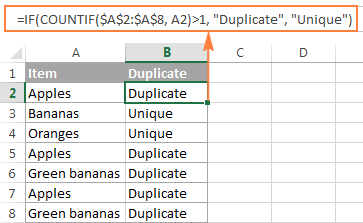
While the thought of a page-long formula including various spreadsheet cells and mathematical symbols is daunting, the formulas used to check for duplicates in Excel are actually quite simple.
Excel find duplicates in a column how to#
How to Find Duplicate Values in Excel Using FormulasĪnother way data analysts can check for duplicates is via Excel formula. And, though a well-liked method, there are advantages to instead using an Excel formula to identify duplicates. There are other suggested options, and Excel also allows for a Custom Format… Once you’re satisfied with the settings, click OK and you’re done!Ī similar method of highlighting duplicates in Excel is available in Google Sheets and other spreadsheet tools. This is where you determine the text and fill color for your highlighting. Light Red Fill with Dark Red Text is the default Format with setting. You may opt to keep the default Format only unique or duplicate values and subsequent duplicate when it comes to choosing which values in the selected range you want.
Excel find duplicates in a column pro#
The Complete Excel Pro Tips Certification Bundle has a retail value of nearly $300, but you can get started for just $19.Spreadsheets are often the best place to store and manipulate data. The learning kit is also broken down into over 100 lectures to help you stay focused. You can work on everything from formatting to analytics and even PivotTables to develop from a beginner to an expert. The hands-on learning kit packs six modules and 11 hours of content to help you sharpen your spreadsheet skills. If you’re ready to level up your skills you can check out the Complete Excel Pro Tips Certification Bundle on Tech Deals. You can learn how to do things like eliminating those duplicates once you find them too. Now you know how to find duplicates in Excel, but what else can you do? There’s so much more to Excel than can fit into one article.

However, the formula is also applied to all other cells with the $A$1:$C$10 conditional formatting instead of retyping the formula individually. Click OK to get your results.Įxcel formulas are cell-based, so A1 in the formula above indicates which cell is being checked. Enter your =COUNTIF formula, in this case, it’s =COUNTIF($A$1:$C$10,A1)=3 because we’re only looking for sets of exactly three. Now select Use a formula to determine which cells to format.Ĥ. This will bring up a menu for you to build your rule. Instead of going to Highlight Cell Rules, go down to New Rule below Icon Sets.ģ. Select your cell range and go back to Conditional Formatting in the Styles section.Ģ. However, it’s slightly trickier as you’ll start to use the COUNTIF function as well. You can expand the duplicate function to work with triplicates and above using some of the same steps. Maybe you’re looking for a way to pair up data points and you need to eliminate third points. See also: How to Check Word Count on Google Docs What about triplicates? For our example, we’re going to color the duplicates green. This is where you can decide how you want to format your duplicate cells.

Go to Highlight Cell Rules and select the Duplicate values option.Ĥ. Now click on Conditional Formatting to open a dropdown menu.ģ. Head up to the Home tab and locate the Styles section. As with any Excel function, you have to decide which data you want to work with.Ģ.


 0 kommentar(er)
0 kommentar(er)
